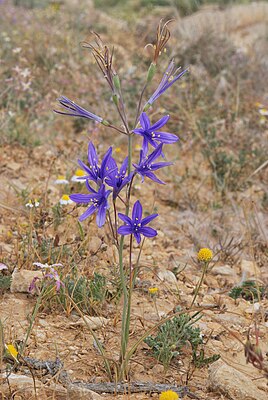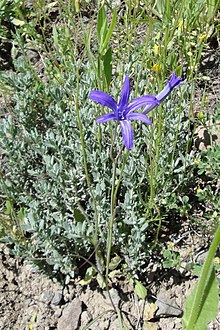Ixiolirion
| Ixiolirion | ||||||||||||
|---|---|---|---|---|---|---|---|---|---|---|---|---|

|
||||||||||||
| Systematics | ||||||||||||
|
||||||||||||
| Scientific name of the family | ||||||||||||
| Ixioliriaceae | ||||||||||||
| Nakai | ||||||||||||
| Scientific name of the genus | ||||||||||||
| Ixiolirion | ||||||||||||
| Fish. ex Herb. |
Ixiolirion , sometimes also called steppe flowers, mountain lilies or blue lilies, is the only genus of the monogeneric family of the Ixioliriaceae in the order of the asparagus-like (Asparagales) within the monocot plants. There are about four species in the genus and therefore family. The species have areas from Egypt to Central Asia and southwest Asia. Blue lilies are rarely used as ornamental plants.
description


Habit and leaves
Ixiolirion species grow as upright, perennial herbaceous plants that reach heights of up to 50 cm. They form (onion-shaped) tubers as persistence organs, which are surrounded by a membrane (tunic).
The more or less pronounced, alternate and spirally arranged leaves in basal rosettes are sessile and simple. The flat leaf blade is linear or lanceolate and parallelnervig. The leaf margin is smooth.
Inflorescences and flowers
In terminal total inflorescences composed of golden , paniculate or racemose partial inflorescences, there are often only a few flowers together. Bracts may be present or absent.
The stalked, large, funnel-shaped, radially symmetrical flowers are hermaphroditic and threefold. The six bracts ( tepals ) are arranged in two circles and not or at most briefly fused at their base. The bracts of the outer circle are usually narrower than those of the inner one. The colors of the bracts range from almost white to purple to blue. There are two circles with three fertile stamens each; they are free to each other but fused with the base of the bracts. The two-celled pollen grains have an aperture and are sulcat. The three carpels are to a predominantly under constant ovary fused with 15 to 50 ovules per ovary chamber. The style, which is much longer than the ovary, ends in a three-lobed stigma. There are nectaries .
Fruits, seeds and seedlings
The three-chamber capsule fruits contain many seeds. The small, wrinkled seeds are black due to phytomelans. The well-formed embryo is almost as long as the endosperm . The cotyledon remains white even when exposed to light.
Ingredients and chromosome numbers
In contrast to the Amaryllidaceae, there are no alkaloids , not even in the blue flowers. There are mucous cells. The basic chromosome number is x = 12.

Systematics and distribution
The distribution area extends from Egypt and Turkey to Central Asia and Southwest Asia. They thrive in temperate areas and in the western Himalayas .
The genus Ixiolirion was first published in 1821 by Friedrich Ernst Ludwig von Fischer in William Herbert : Bot. Reg. , An Appendix Bot. Reg., 37. A synonym for Ixiolirion Herb. is Kolpakowskia's rule . The Ixioliriaceae (Pax) Nakai family was published by Nakai Takenoshin in Chosakuronbun Mokuroku , 234 on July 20, 1943 .
The genus Ixiolirion was formerly in the Amaryllidaceae J.St.-Hil. classified. The family of the Ixioliriaceae (Pax) Nakai is the Alliaceae Batsch ex Borkh. and especially close to the Tecophilaeaceae Leybold .
There are about (one to) four species in the genus Ixiolirion :
- Ixiolirion ferganicum Kovalevsk. & Vved. : The home is Kyrgyzstan .
- Ixiolirion karateginum Lipsky : The home is Central Asia and northeast Pakistan.
- Ixiolirion songaricum P.Yan : It was first described in 1996. It thrives on dry slopes and fields at altitudes of 400 to 1600 meters. It is endemic to northeast China and is only found in Xinjiang in the Tianshan Mountains.
- Mountain blue lily or mountain amaryllis ( Ixiolirion tataricum ( Pall. ) Herb. , Syn .: Amaryllis tatarica Pall. , Amaryllis montana Labill. , Ixiolirion montanum (Labill.) Herb. , Ixiolirion pallasii Fisch. & CAMey. Ex Ledeb. ) : There have been two varieties since 1984:
- Ixiolirion tataricum var. Ixiolirioides (rule) XHQian : It occurs from Central Asia to northern Xinjiang .
- Ixiolirion tataricum (Pall.) Herb. var. tataricum : It occurs from eastern Turkey to Kashmir .
literature
- The family of Ixioliriaceae in APWebsite. (Sections Description and Systematics)
- The Ixioliriaceae family at DELTA by L. Watson & MJ Dallwitz. (Section description)
- Zhanhe Ji, Alan W. Meerow: Amaryllidaceae : Ixiolirion , p. 269 - online with the same text as the printed work , In: Wu Zheng-yi, Peter H. Raven (Ed.): Flora of China , Volume 24 - Flagellariaceae through Marantaceae , Science Press u. a., Beijing and St. Louis, 2000, ISBN 0-915279-83-5 . (Sections Description and Systematics)
- E. Nasir: Ixioliriaceae at Tropicos.org. In: Flora of Pakistan . Missouri Botanical Garden, St. Louis
Individual evidence
- ^ Ixioliriaceae at Tropicos.org. Missouri Botanical Garden, St. Louis, accessed July 23, 2018.
- ↑ a b c d e f Rafaël Govaerts (Ed.): Ixioliriaceae. In: World Checklist of Selected Plant Families (WCSP) - The Board of Trustees of the Royal Botanic Gardens, Kew . Retrieved July 23, 2018.
Web links
- Ixioliriaceae at Tropicos.org. In: IPCN Chromosome Reports . Missouri Botanical Garden, St. Louis
- Entry at pacificbulbsociety.org